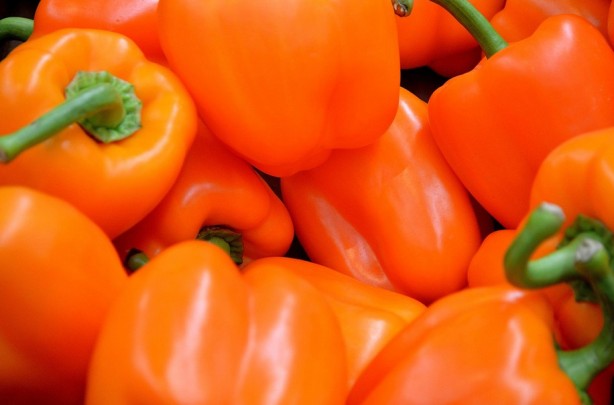
Orange peppers look great in the garden, and the ready-made dishes make them more attractive. But the dignity of the varieties is not only in the original color. Why you need to plant orange bell pepper in your garden, what are its advantages, what should be taken into account when growing, and what varieties of orange pepper are recognized as the best, we will consider in the article.
Content
Description and characteristics of orange pepper
Orange bell peppers create a sunny mood both on the garden bed and on the table, and also greatly benefit the human body. It has a lot of nutrients, vitamins and minerals. Compared to other varieties, it has a significantly higher content of potassium, phosphorus and rutin, and in green is an excellent way to prevent cancer and the formation of tumors.
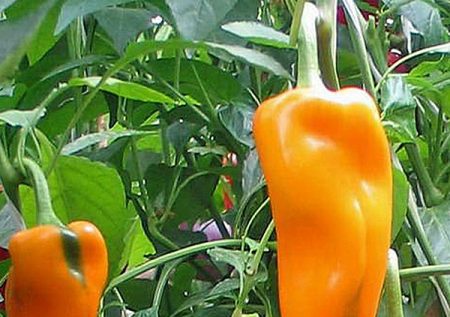
Varieties of orange pepper can be super-early, early, mid-ripening and late. But even the most precocious have a rather long vegetative period, so they are grown exclusively in seedlings.
In fact, experienced gardeners plant peppers of different ripening periods. This allows you to have fresh fruits on the bed throughout the season.
You can grow orange peppers in the open ground, and in the greenhouse, and even at home on the balcony or on the windowsill. Information on recommended growing conditions should be indicated on the packaging with seeds. After all, he will not be able to give pepper intended for growing in a greenhouse of the same crop in the open ground.
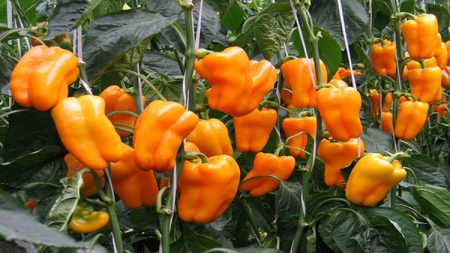
When choosing varieties, you should also pay attention to the appearance of a potential resident of a personal plot. This primarily concerns the height and width of the bush. If it is not possible to organize reliable props, it is better to give preference to undersized orange peppers.
Of great importance is the resistance to disease. Most varieties of orange peppers on sale today are hybrids and have already been treated for infections and pests.
Useful properties of orange pepper
Orange color indicates a large number of carotenes. Translated from Latin, this word means "carrot" and indeed, the vegetable got its name precisely for its original shade. It was previously believed that it was carrots that beneficially affect vision and is a leader in the content of the substances necessary for this, but after the selection of orange bell pepper by breeders, it was he who became the winner in such a competition.
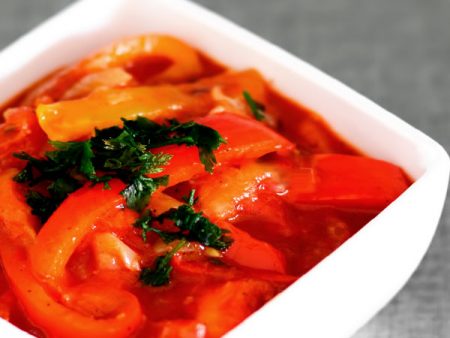
In addition to carotene, such a pepper has a huge amount of vitamin C. In this regard, it is able to even surpass the lemon! And the vitamins of groups A, B, P and E, iron, magnesium, sodium phosphorus and other trace elements make the vegetable a real treasure for every person.It is very important that it does not cause allergies, and due to its low calorie content (26 Kcal per 100 grams of product) does not harm the figure.
Early orange varieties
They say that early varieties of pepper have no particular taste or smell. Perhaps, but not the representatives of the orange group. All of them are characterized by a bright color, thick fleshy, juicy walls, increased productivity and rich taste.
Let us dwell briefly on the most popular early varieties of orange pepper.
Orange Vander
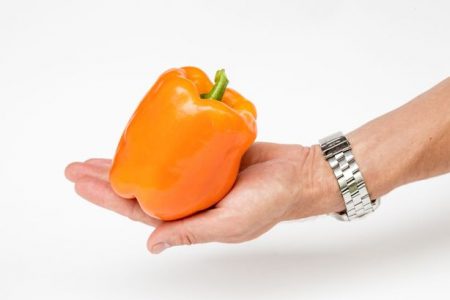
This hybrid allows you to collect fruits 100-105 days after the appearance of the first seedlings. By this time, the fruits are still green, but already edible. Orange color acquire later. The weight of one pepper is 250 g, the wall thickness is about one cm.
It is characterized by increased germination of seeds. It can be grown in open ground, but gives the best result in hotbeds, when placing 3 bushes per meter kV.
The bush reaches a height of one meter, so it needs supports. From one meter of kV up to 15 kg of fruit.
It is mainly eaten fresh or as part of salads.
Orange bull
This orange pepper was loved by gardeners not only for its early ripening and good germination. Its main advantage is increased productivity. Even in a small area, you can grow enough fruits for the whole family.
The fruits are quite large. Weight can be from 200 to 450 g. The shape is slightly elongated. Wall thickness up to one cm.
It can be grown both under the film and in the open ground. Resistant to diseases and pests, not afraid of even tobacco mosaic viruses.
It is used fresh, suitable for freezing and canning, only because of the size of the fruits, they do not fit entirely in a jar, so you have to cut into pieces.
Kinkan
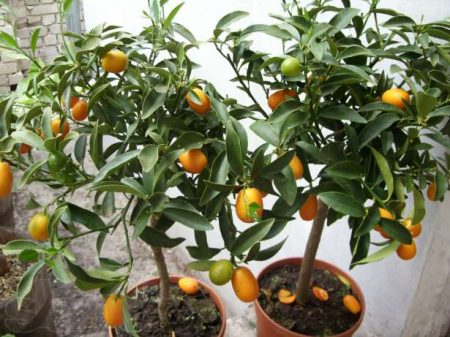
This hybrid is often chosen as an ornamental plant because of the neat shape of low bushes and mini-fruits, but their taste is more than decent, so the variety can be called universal.
It can be grown in a greenhouse, and in the open field, and at home. Kinkan, planted in a decorative flower pot, looks very beautiful. The bush with leaves of deep green color is abundantly strewn with orange peppers up to 5 cm in size. The pepper is eaten fresh, added to salads, first and second courses, used for preservation.
Orange mini
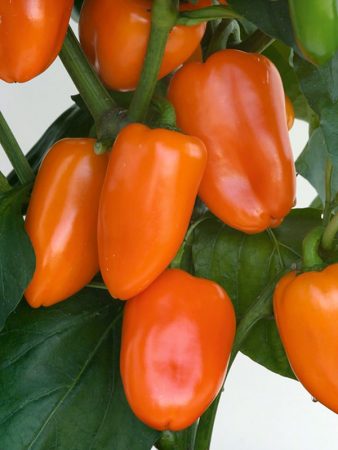
Another hybrid related to mini peppers. It can also be grown in open and closed conditions. The bush is up to half a meter, lush and covered with fruits weighing up to 35 grams. Resistant to disease. He loves moisture and heat, requires increased nutrition.
It contains a lot of vitamin C and sugars.
It is used for preparing fresh summer dishes, as well as for preservation.
Amber
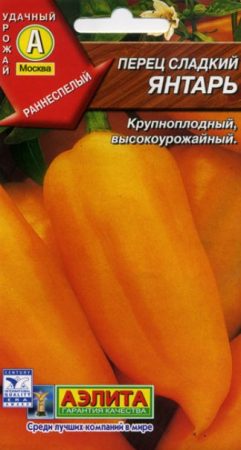
Technical ripeness of this sweet pepper occurs 110 days after emergence, but by this time the fruits are still green. Only after 2 weeks will they become saturated orange. You can pick them from the bushes green and leave them to ripen at home, only then the color will be more dark yellow than orange.
Peppers are medium sized. Weight have up to 100 gr. Bushes grow to a meter, so they need a garter.
Use in cooking is universal.
Orange miracle
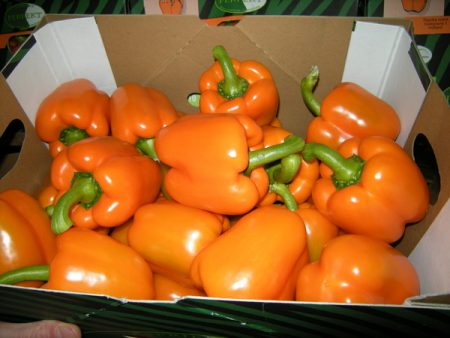
This hybrid is the most popular among all orange varieties. You can determine it by a brighter color. Harvest can be harvested after 90-95 days. Fruits weighing up to 250 grams have a cube shape and a very pronounced pleasant taste.
The walls are thick, about 7-9 mm. The pulp is juicy. The bush reaches a height of up to a meter, so backup is required.
It can be grown in open and closed ground. Needs enhanced nutrition, especially during flowering and fruiting.
It has an attractive appearance, is well stored and easily transfers transportation, therefore it is often grown for sale.
Orange enjoyment
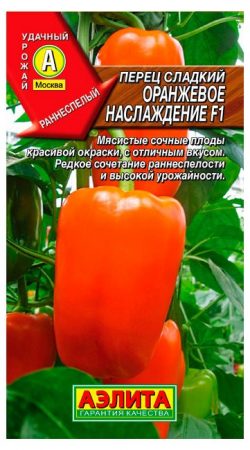
This precocious hybrid has a small compact bush and medium-sized fruits. It can be grown in any conditions.Suitable not only for open and closed beds, but also for breeding houses on window sills or on balconies.
Pepper is very beautiful. Despite its small size, it has very thick walls of up to one cm. At the same time, 15-20 fruits can be located on the bush. They change color as they mature, which gives even more charm.
With a meter of kV, you can collect 10-15 kg, depending on the stability of environmental conditions and soil nutrition.
The undoubted advantage of the variety is that even after processing it does not lose its taste and aroma.
It is also popular due to its excellent presentation, keeping quality and resistance to transportation even over long distances.
Orange beauty
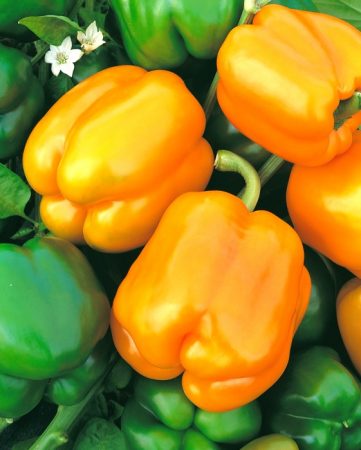
This hybrid is pretty tall. The bush can grow up to a meter and slightly higher, but due to the fact that it belongs to the standard, it does not require formation. It grows on any type of soil. Harvest from a meter of kV up to 10 kg. It should not be planted too often. On a meter of kV there should be no more than 7 bushes, otherwise the plants will obscure each other.
Harvesting is possible already in 90-95 days after the first seedlings. The fruits are large, weighing 210-250 gr, very juicy. The taste is sweetish.
The variety is resistant to many diseases, including verticellosis wilting.
The early varieties of orange bell pepper that we have listed are considered the most proven. They give a good harvest, do not need special care, withstand pest attacks, are resistant to infections and fungi. But besides this, they have a rich taste and a very pleasant aroma, as well as a huge amount of vitamins.
Other orange varieties
Early pepper varieties are indispensable for regions with a short summer. They give a harvest in June. But middle and late varieties can also be grown in parallel to get a crop throughout the season. Therefore, the best representatives of these categories will also not hurt to get acquainted briefly.
Big gold
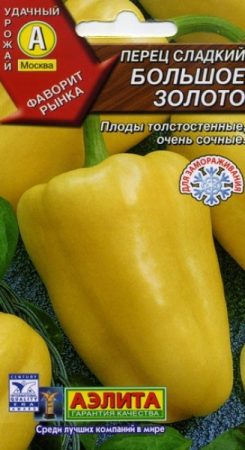
The variety is mid-early. It can be grown both under film and in open ground. Fruits contain an increased amount of vitamin C. In biological ripeness, they acquire a saturated yellow color with an orange tint. Fruit weight up to 220 g, wall thickness up to 8 mm.
In cooking, the use is universal. It has a pleasant sweet taste and a very rich aroma.
Bushes of medium height (up to 75 cm). With a meter of kV it turns out to collect up to 7 kg of pepper.
Orange lion
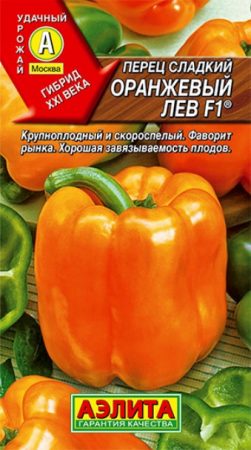
This variety surprises with an unusual combination of a small bush height (up to 45 cm) and rather large bright orange fruits (up to 300 gr).
Ripens by about 120 days after emergence.
A hybrid of this variety has recently been bred. The orange lion F1 is intended exclusively for greenhouses, the bushes grow to a meter, and the fruits are the same size as that of the next of kin.
Choosing between the original and the hybrid, focus on the natural conditions of the region and the place in which you will grow it
Orange classic
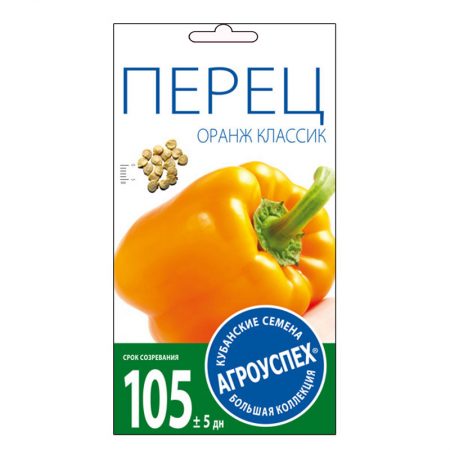
Mid-early variety. It ripens in 95-120 days, depending on whether it is grown in open ground or in a greenhouse.
Fruits weigh no more than 100-120 gr. They differ in an interesting conical shape and upward growth. Bushes of medium spreading, up to 60 cm high.
In technical ripeness, the fruits are green, and in biological ripe orange. Juicy, sweet, fleshy. They can be used both fresh and for any culinary recipes.
Fox
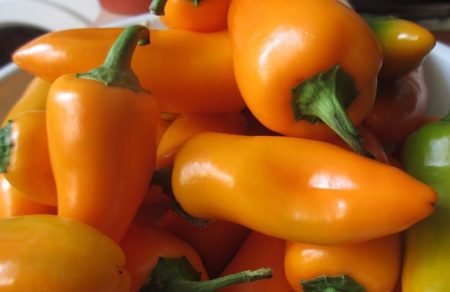
Peppers of this variety are considered the smallest among orange. "Chanterelle" is suitable for growing at home or in a greenhouse. One fruit weighs only 25-35 g, but it is very pleasant to taste and the aroma is quite saturated. From one bush, even when grown on a windowsill, up to 1.2 kg is obtained, and in a greenhouse the indicator rises by about two times.
110 days pass from the appearance of seedlings to technical ripeness, 130-135 days to biological ripeness.
Governor
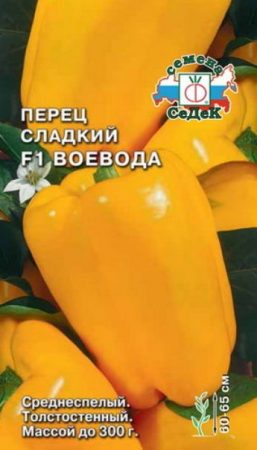
The mid-early variety is intended for cultivation in open ground and a greenhouse. The bush reaches 65 cm in height. Fruits are green in technical ripeness and weighing up to 180-200 g, in biological ones - orange and weighing up to 300 g. The pulp is sweet, juicy, aromatic. Wall thickness 6-7 mm.
Productivity is high. With a meter of kV comes up to 8-10 kg. In terms of cooking, it’s universal.
Orient Star Orange
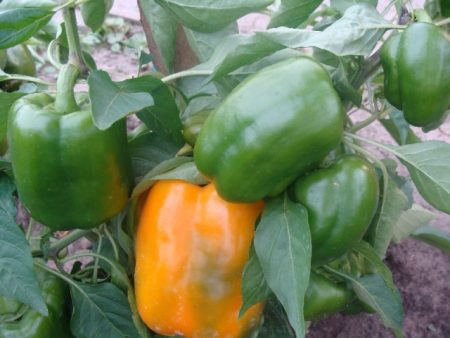
This mid-early variety ripens in 115-120 days. Suitable for both open and closed ground. Bush 60-70 cm high, medium spread. Fruits are yellow-orange, sweet, fragrant. The weight of one is up to 200 gr.
It is resistant to viral diseases. Subject to the rules of agricultural technology, it is possible to collect up to 8 kg of fruits from a meter of kV.
It is used fresh, suitable for preservation and freezing. It doesn't turn out very well stuffed.
Oriental Star Mandarin
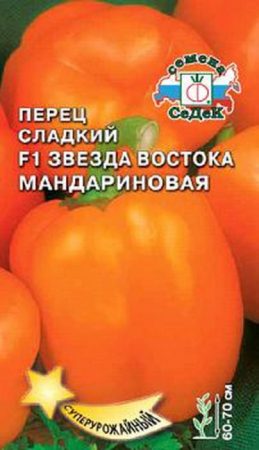
Hybrid refers to early ripening. The bush reaches a height of 80 cm, needs a garter. The fruits are juicy, fleshy, dark orange in color, cubic in shape, weighing up to 230-250 gr.
With a meter of kV, you can collect up to 7-7.5 kg.
Due to its good presentation, a predisposition to long-term storage and endurance even of long-distance transportation is often grown for sale.
Use in cooking is universal.
Sun
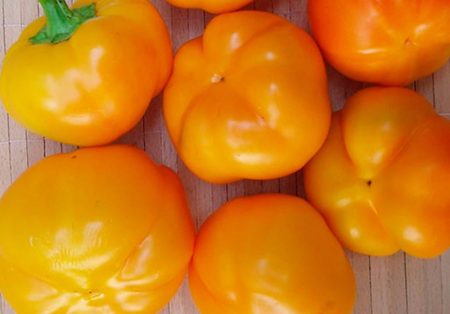
Pepper "Sun" is low. The bushes are not sprawling; they do not grow above 45 cm. The fruits have a mass of 60-80 g, a saturated yellow-orange color, thin skin, pronounced pleasant taste without bitterness. It can be grown both in open and in closed ground.
Refers to mid-season. 115 days pass before technical maturity, 160 days before biological maturity.
Very fond of sunshine and high humidity. Resistant to verticillus wilting and rotting fruits. The application in cooking is universal.
Firefly
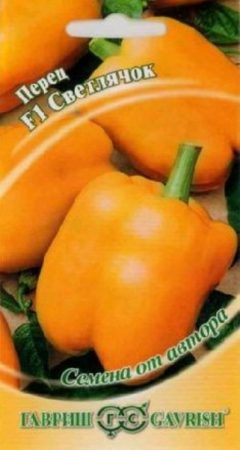
Mid-early hybrid bred exclusively for growing in greenhouses. From the moment of emergence of the shoots and until the harvest takes 120-130 days. The medium-spreading bush reaches a height of 70 cm. The fruits of a pyramidal shape weigh about 100 grams. The taste is sweetish, the aroma is pronounced. From one bush leaves up to 1.5-1.7 kg of fruit.
The main difference between the variety is that it is never green. In the state of technical maturity, the fruits are yellow, in the biological - bright orange.
Orange king
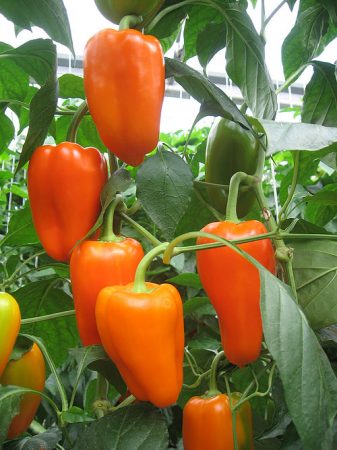
Mid-season hybrid matures in 110-130 days. In technical ripeness is dark green, in biological - light orange. The average weight of the fetus is 175-180 gr. The taste is pleasant, the aroma is full.
The plant is medium tall, quite compact. With a meter of kV, 4-6 kg of fruits are harvested.
Designed for growing under a film, but if the region has stable weather conditions, you can plant it in open ground.
It is used fresh and for conservation.
Ginger
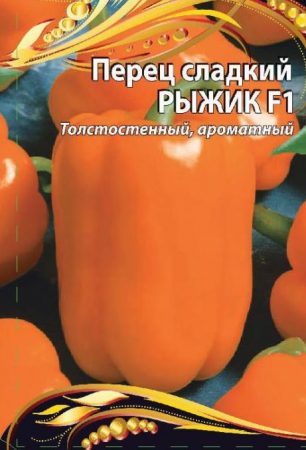
The early ripe hybrid is intended for cultivation in the open and closed soil. The plant is half-stemmed. The bush does not form, only one main stem remains.
Fruits can be harvested 98-105 days after the appearance of the first seedlings. The fruit is slightly elongated, weight up to 160 g. The wall is thick, up to 9 mm. The pulp is very fragrant, juicy, sweet. Suitable for all kinds of recipes.
It is characterized by long fruiting, the main thing is to collect ripened peppers in time.
Orange jubilee
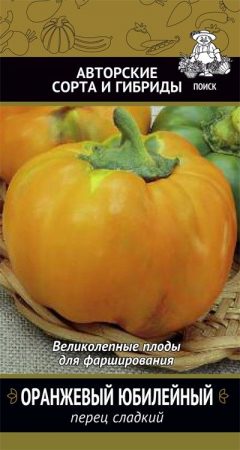
The variety is early. Suitable for outdoor and indoor use. Bushes of medium height.
The fruits are harvested 95-100 days after the appearance of the first seedlings. The shape is tomato-like, round. Fruit weight 85-90 gr. Wall thickness up to see. The pulp is juicy, sweet.
Suitable for any recipes and just perfect for stuffing.
Rules for growing orange pepper
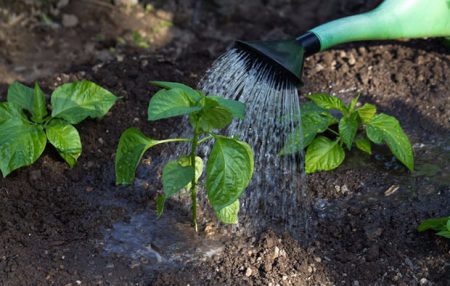
Agricultural techniques for growing orange bell peppers are similar to other varieties.It is also planted on seedlings in mid-February and early March. After the appearance of two true leaves, a dive is carried out, a root and, after two weeks, foliar top dressing is carried out. Before planting on the bed, hardening is mandatory. But there are also nuances that must be taken into account in order to get a good harvest.
Orange peppers are considered to be sissies and indeed, this culture is quite demanding in the first place to air temperature. If the nights are cool, it is necessary to use a shelter, to prevent drafts during the cultivation of seedlings. Of great importance is humidity. Overdrying of soil or air is fraught with disease and even death of plants.
It does not hurt to provide additional protection to the root system. The main recommendation for this is to plant seeds not in a common container, but immediately in separate cups. Very good if you can use peat. Then the sprout, ready to move into the ground, can be planted in the hole directly in it and significantly reduce possible damage.
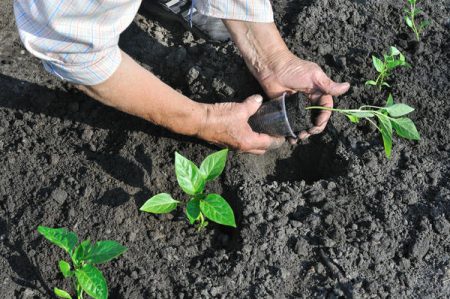
Some varieties are allowed to pluck at the time of technical maturity and leave for ripening. But it should be understood that fruits can acquire the maximum amount of nutrients exclusively in natural conditions and only when they receive enough light, heat, moisture and vital juices from the soil.
Reviews
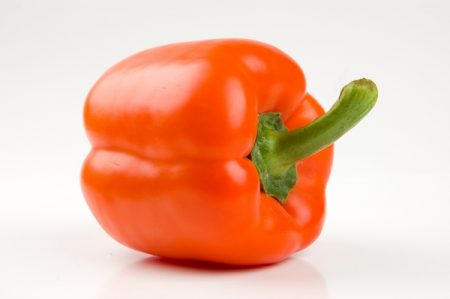
Nikolay Pavlovich, 58 years old
Orange pepper has always been on my beds. I don’t particularly understand the varieties, because basically I harvest the seeds on my own and just get confused in them. I used to think that huge bell peppers, which are cast in a glossy sheen and sold in stores mainly in the early spring or in the winter, are very harmful and grow only abroad.
I don’t know about the nitrate content in them, but I learned that such giants could be grown in the garden only this year. The neighbor himself grew seedlings and gave me some bushes. This is just a miracle. It is a pity that almost all orange peppers are hybrids and seeds only need to be bought, but they will not be able to prepare themselves.
Alevtina Viktorovna, 63 years old
I do not like to experiment. I try to grow only those crops that have long been known and tested. But this year's daughter-in-law planted new varieties of pepper. I really liked it. If you do not pick them green, then first they turn yellow, and then bright orange. They even taste different. I would like not to spend such a treasure on conservation, but to eat only fresh.
Natalia, 30 years old
I am very glad that every year there are more and more varieties of vegetables that can be grown at home. We have a summer house, but you don’t run into it all the time to water and fertilize on time. Therefore, plants in pots are the best option. I advise everyone to plant orange mini peppers. They will not require a lot of free space, and you will have fresh vitamins on hand almost all year round. And what a beauty, when it is raining or snowing outside the window, and peppers are growing wildly on the windowsill!
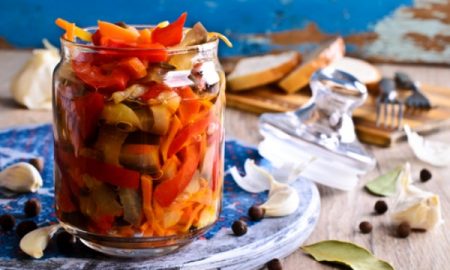
Many gardeners acquire orange peppers because of their original appearance, but they are sure that after tasting once and learning about their incredible benefits, there will be more fans.




 Calorie pepper stuffed with meat and rice - BZHU per 100 grams
Calorie pepper stuffed with meat and rice - BZHU per 100 grams Gorky pepper - the best varieties for open ground
Gorky pepper - the best varieties for open ground Hot pepper seeds - the best varieties for open ground and reviews
Hot pepper seeds - the best varieties for open ground and reviews Capsicum tincture for hair - how to use and reviews
Capsicum tincture for hair - how to use and reviews